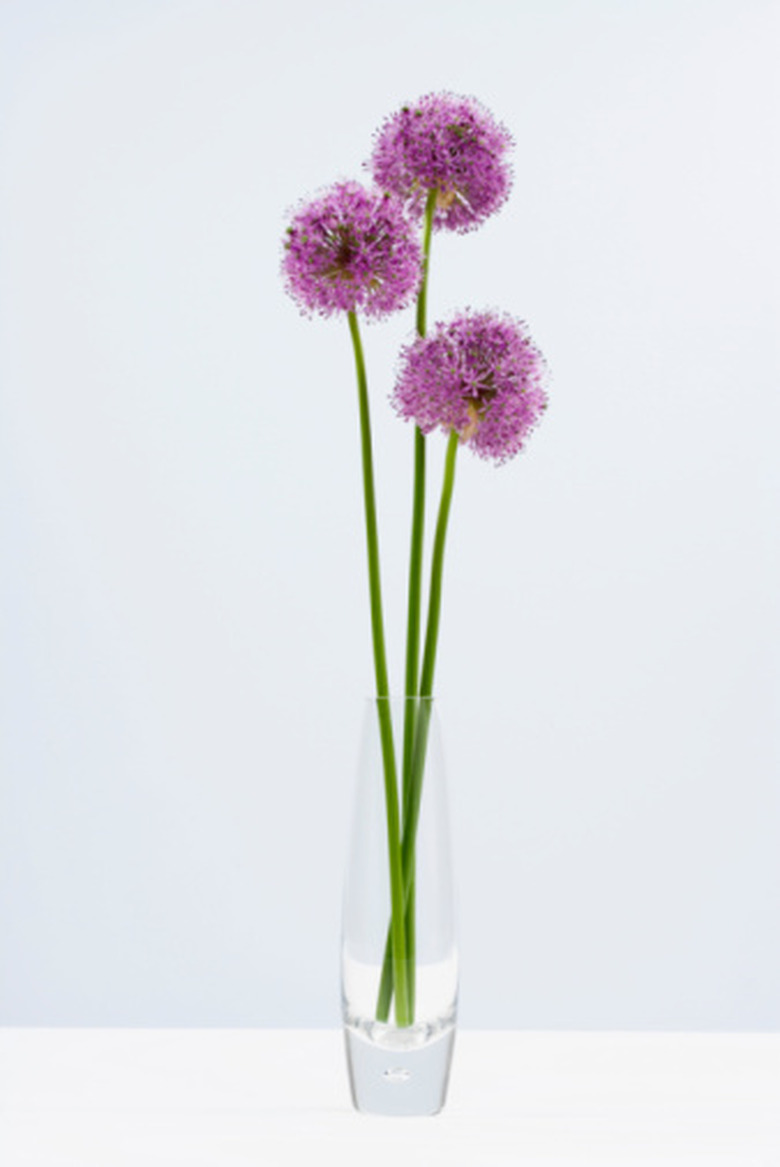How To Force Allium Bulbs
Things Needed
- Containers
- Sand-base potting mix
- Cold refrigerator
- Thermometer
- Fluorescent grow lights
Tip
In the latter days of cold treatment, the onions may already be sprouting leaves that are 1 to 2 inches tall. With no light they will look white, not green. Once they are relocated to a sunny spot after the cold treatment, leaves quickly green up. Rotate the containers once growing to keep leaves and flower stems from leaning toward any sources of light. Ornamental onions that grow with shorter stems are easier to force to grow straight than those with towering stems. Moreover, tall flower stems flop more easily if light is weak or if the container isn't large or heavy enough to support them.
The botanical genus Allium comprises garlic, chives and onions used for food, but also a wide array of ornamental onion species prized for showy flowers. Forcing, the process of chilling bulbs and growing them indoors out of season, is more challenging for ornamental onions. Unlike daffodils or tulips, ornamental onions need a longer and colder exposure to chilly temperatures followed by long exposure to bright light to grow their best in an indoor environment. If these conditions aren't met, the bulbs only produce leaves or any flower stalks grow weak and topple once the flower head forms.
Step 1
Fill containers with a fertile but fast-draining potting soil mix, such as a sand-based cactus/succulent medium. Regular potting soil works as long as it contains coarse materials like perlite and bark to ensure good drainage. Mississippi State University mentions that a 6- to 10-inch-diameter pot often works well, especially if the ornamental onion bulbs are large.
Step 2
Plant the ornamental onion bulbs in the containers so that the pointed tips orient upward. Cover the bulbs with soil so that there is one only 1 inch covering the tip of the bulbs. In Brooklyn Botanic Garden's "Bulbs for Indoors," three bulbs per 6-inch pot is ideal since it allows for root growth and the pot is large enough to support the weight of the leaves and flowers later once they grow upward.
Step 3
Water the planted containers to thoroughly moisten the soil. Allow the water to fully drain from the bottom of the container. Do not position containers where standing water pools and keeps the soil saturated. This quickly leads to onion bulb rot.
Step 4
Place the containers in a cool, dark location for 10 to 12 weeks. An ideal temperature of 38 and 42 degrees Fahrenheit allows the bulbs to grow extensive roots. A cold frame, unheated garage or a spare refrigerator are all viable choices to create conditions for the cold treatment known as vernalization.
Step 5
Monitor the container soil weekly, adding cool water to keep the soil evenly moist but never soggy. Relocate the containers to a separate drainage area like a sink to allow water to drain after watering. Then place them back in the clean, dry area for continued cold treatment.
Step 6
Relocate the containers with ornamental onion bulbs to an even colder area after the initial 10- to 12-week treatment Using a thermometer, confirm the new, dark chilling area provides a temperature between 32 and 35 degrees Fahrenheit. Expose the containers to this colder regime for an additional eight to 10 weeks.
Step 7
Monitor the containers throughout the colder chilling treatment and water when the soil gets slightly dry. Maintain an evenly moist but never wet soil.
Step 8
Remove the containers from the cold treatment once 21 weeks passes, which includes both the cool and colder temperature treatments. Place the pots with bulbs in a sunny room where the temperatures are cool, ideally between 55 and 60 degrees Fahrenheit. Warmer temperatures cause the flower stalks to grow too quickly and become weak, not able to support the flower heads well.
Step 9
Set up supplemental fluorescent grow lights over the containers with bulbs. The ornamental onions need as bright a light as possible, and depending on time of year, you need to provide light so they bask in 12 to 16 hours of light daily. A mix of natural sunlight with fluorescent grow light suffices, with the use of the artificial lights best in the morning and evening hours when sunlight through windows is weak.
Step 10
Lift the height of the artificial lights as needed to allow for the upright growth of the ornamental onion flower stems and leaves. Once flower buds appear, a room temperature between 50 and 55 degrees Fahrenheit slows the flower maturation so you enjoy the flowers for up to 10 days (depending on species or cultivar).
Step 11
Maintain an evenly moist soil throughout the duration of growth of the ornamental onions. Again, never allow the soil to remain soggy or let the pot bottoms rest in a pool of drainage water. Wet soil causes onion roots to rot and any leaves and flowers to abort.
References
- "Brooklyn Botanic Garden Bulbs for Indoors"; Robert M. Hays and Janet Marinelli, editors; 1996
